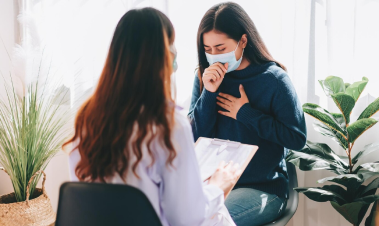Are you feeling extreme chest pain, breathing difficulty, or a persistent cough? These may be the symptoms of respiratory disorders.
Respiratory disorders encompass a diverse array of health conditions that affect the intricate and vital system responsible for our breath. However, the good news is that many respiratory disorders can be prevented with proactive measures.
By exploring its cause, symptoms, and treatment options, individuals can safeguard their respiratory health by adopting healthier habits, avoiding exposure to harmful substances, and maintaining good hygiene practices.
This comprehensive blog will delve into the spectrum of symptoms, causes, and treatment options for respiratory disorders.
What Is Respiratory Disorder?
Respiratory disorders are a group of medical conditions that affect a person’s respiratory system, such as the lungs, nose, mouth, windpipe, throat, and voice box.
Symptoms of Respiratory Disorder
Respiratory disorders affect the lungs and airways, leading to a wide range of symptoms that can significantly impact a person's breathing and overall well-being. These disorders can be acute or chronic, infectious or non-infectious.
Here are some common symptoms:
-
Wheezing: A high-pitched whistling sound during breathing, caused by narrowed airways, is characteristic of conditions like asthma and chronic obstructive pulmonary disease (COPD).
-
Chest tightness or pain: Respiratory disorders may cause chest discomfort, ranging from mild to severe, depending on the underlying cause.
-
Sputum production: Excessive production of thick, coloured mucus may be present in conditions like bronchitis, pneumonia, or cystic fibrosis.
-
Extreme tiredness: Respiratory disorders can cause reduced oxygen intake, leading to fatigue and weakness.
-
Rapid breathing (tachypnea): A faster-than-normal breathing rate is often seen in acute respiratory infections.
-
Cyanosis: Bluish discolouration of the lips, fingertips, and skin is a sign of low oxygen levels in the blood.
-
Chronic cough: Some respiratory conditions, like chronic bronchitis and interstitial lung diseases, can cause a long-term, persistent cough lasting for months.
-
Nasal congestion: Respiratory infections, such as the common cold or flu, often lead to a stuffy or runny nose.
-
Respiratory infections: People with compromised respiratory systems may be more susceptible to infections, leading to recurrent bouts of bronchitis or pneumonia.
-
Clubbing or swelling of fingers and toes: In some chronic respiratory disorders, the fingertips and toes may become enlarged and rounded.
However, please note that these symptoms alone do not indicate a specific respiratory condition, as many of them can overlap. It’s better to visit a healthcare professional for an accurate diagnosis.
Causes of Respiratory Disorders
Respiratory disorders encompass many conditions that affect the lungs and the respiratory system. These disorders can have various causes, including environmental and genetic predispositions. Understanding the underlying causes is crucial for prevention, early diagnosis, and effective treatment.
Here are common causes of respiratory disorders:
-
Smoking and Tobacco Use: Cigarette smoking and other forms of tobacco consumption are the leading preventable causes of respiratory disorders.
-
Pollutants: Exposure to indoor and outdoor air pollutants can significantly impact respiratory health. Particulate matter, nitrogen dioxide, ozone, and volatile organic compounds are common pollutants that can irritate the airways and lead to respiratory disorders.
-
Allergens: Allergic reactions to substances such as pollen, mould, pet dander, dust mites, and certain foods can trigger respiratory disorders like asthma.
-
Occupational Hazards: Certain workplaces expose individuals to respiratory hazards like asbestos, silica, coal dust, and other harmful chemicals. Prolonged exposure to these substances can cause respiratory disorders such as pneumoconiosis, occupational asthma, and work-related COPD.
-
Respiratory Infections: Viral and bacterial infections, such as influenza, pneumonia, tuberculosis, and respiratory syncytial virus (RSV), can affect the respiratory system and cause inflammation in the lungs and airways.
-
Genetic Factors: Some respiratory disorders are caused by genetic factors.
To effectively prevent or treat respiratory diseases, it is important to maintain a healthy lifestyle, avoid tobacco smoke and other pollutants, and see a doctor for advice if you notice respiratory symptoms.
Prevention of Respiratory Disorders
Preventive measures are crucial in reducing the incidence and severity of respiratory disorders, promoting better lung health, and improving overall well-being.
Here are some key strategies to consider:
-
Avoid Smoking: Quitting smoking and avoiding exposure to secondhand smoke are essential steps in preventing respiratory disorders.
-
Maintain good indoor air quality: Regularly ventilating living spaces, using air purifiers, and keeping the home free from mould, dust, and other allergens can significantly improve indoor air quality.
-
Regular exercise: Exercise is necessary to strengthen the respiratory muscles and improve lung function.
-
Managing Allergies: Manage allergies effectively with medication and allergen avoidance.
-
Maintaining a Healthy Lifestyle: A healthy lifestyle can improve lung function and reduce the risk of respiratory disorders.
By following these preventive measures, you can go a long way in protecting yourself from respiratory disorders and maintaining optimal lung function. Remember, prevention is always better than cure!
Diagnosis of Respiratory Disorders
Diagnosing respiratory disorders involves a series of tests that help healthcare professionals identify and understand the underlying cause of respiratory disorders.
These diagnostic tests include:
-
Medical History: The first step in diagnosing a respiratory disorder is taking a detailed medical history. The healthcare provider will ask questions about the patient's symptoms, duration, any triggers or aggravating factors, past medical conditions, family history, and lifestyle habits like smoking or exposure to pollutants.
-
Physical Examination: A physical examination assesses the patient's overall health and specifically focuses on the respiratory system.
-
Lung Function Tests: Doctors perform lung function tests to check for extreme conditions such as asthma and COPD. Spirometry assesses lung capacity, airflow rate, and how effectively the patient can exhale.
-
Imaging Studies: Chest X-rays and computed tomography (CT) scans provide detailed images of the lungs and chest area. These imaging studies can help detect abnormalities such as tumours, infections, or structural issues within the respiratory system.
-
Blood Tests: Blood tests may be conducted to evaluate oxygen and carbon dioxide levels, assess white blood cell counts for signs of infection, or check for specific markers related to certain respiratory disorders.
-
Sputum Analysis: In cases of respiratory infections or chronic lung conditions, a sample of sputum (mucus coughed up from the lungs) may be collected and analysed for the presence of pathogens, white blood cells, or other indicators of disease.
-
Bronchoscopy: It helps diagnose conditions like lung cancer, infections, and certain inflammatory diseases.
Treatment options for Respiratory disorders
The treatment options vary from patient to patient. Your doctor decides your condition based on your diagnostic results and starts treatment accordingly.
Here are some common treatment approaches:
-
Medications: These may include bronchodilators, corticosteroids, antibiotics (for bacterial infections), antiviral drugs (for viral infections), and other specific medications to manage symptoms and underlying causes.
-
Oxygen therapy: Supplemental oxygen may be administered for individuals with severe respiratory issues.
-
Allergen immunotherapy: For those with severe allergies, allergen immunotherapy (allergy shots) may be recommended to reduce sensitivity to specific allergens.
-
Pulmonary rehabilitation: During this treatment option, you will learn breathing techniques and exercises which improve your breathing capacity.
-
Surgery: In some cases, surgical interventions may be necessary to treat structural issues in the respiratory system or remove tumours.
Conclusion
Respiratory disorders present significant challenges to individuals and their loved ones, as they can profoundly impact one's quality of life and overall well-being. This comprehensive exploration of symptoms, causes, prevention, and treatments underscores the importance of understanding and addressing these conditions with empathy and compassion.
Experts at Saroj Super Speciality Hospital are dedicated to providing the best treatment for any respiratory disorder. Our extensive knowledge and experience in the field make their doctors and specialists well-equipped to diagnose and manage a wide range of respiratory conditions.
When it comes to respiratory disorders, you can trust the experts at Saroj Super Speciality Hospital to deliver exceptional care. We are committed to providing comprehensive treatment options that address both short-term relief and long-term management of respiratory conditions. Your health is our priority, and we strive to ensure that you receive the best possible care every step of the way.
FAQs About Respiratory Disorders
Ques 1. What are the common symptoms of respiratory disorders?
Ans. The common symptoms of respiratory disorders include,
-
Breathing difficulty
-
Persistent cough
-
Extreme chest pain or tightness
-
Rapid or shallow breathing
-
Chronic mucus production
-
Fatigue
-
Recurrent respiratory infections
-
Wheezing
Ques 2. What are the causes of respiratory disorders?
Ans. Respiratory disorders can be caused by various factors, including
-
Smoking
-
Infections (viral, bacterial, or fungal)
-
Genetic factors
-
Allergens (pollen, dust mites, pet dander)
-
Environmental pollutants
-
Occupational hazards
-
Age-related changes in the respiratory system
Ques 3. How can I prevent respiratory disorders?
Ans. The preventive measures include
-
Avoiding smoking and passive smoke
-
Maintaining good indoor air quality
-
Practising good hand hygiene
-
Getting vaccinated against respiratory infections
-
Regular exercise
-
Following safety guidelines at work
-
Managing allergies effectively
Ques 4. What is the treatment for respiratory disorders?
Ans. The treatments for respiratory disorders depend on the specific condition and its severity. They may include medications (bronchodilators, corticosteroids, antibiotics, etc.), oxygen therapy, pulmonary rehabilitation, lifestyle changes, allergen immunotherapy, surgery, and management of co-existing conditions.
Ques 5. When should I seek medical attention for respiratory symptoms?
Ans. If you experience persistent respiratory symptoms such as shortness of breath, chronic cough, chest pain, or any other respiratory issue, it's essential to seek medical attention promptly for proper evaluation and management.



